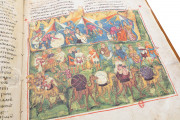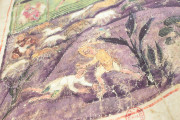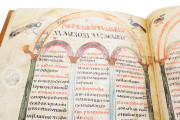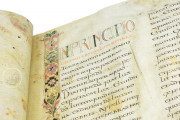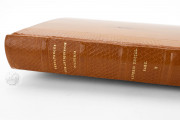The Tours Pentateuch is one of the few surviving manuscripts from the pre-Carolingian period. Also called the Ashburnham Pentateuch, after Bertram Ashburnham, who purchased it from Guglielmo Libri after the latter stole it from the Tours public library. The facts surrounding the book’s creation are uncertain. It likely dates to the decades around the year 600. The production center may have been Rome, however Spain or North Africa are also possibilities. Although its origins are unknown, it was in Fleury by the eighth century and in Tours by the ninth century where it underwent some restoration.
The manuscript preserves a fragmentary copy of a pre-Alcuin Vulgate Latin version of the first five books of the Old Testament along with eighteen of the original sixty-nine images. Its images served as iconographic models for Carolingian artists and were fundamental for the depiction of narrative in Western medieval art.
The Manuscript Foundations of Old Testament Iconography
Wherever the Pentateuch was originally made, likely somewhere near the western Mediterranean coast, it was soon taken north, first to Fleury, where twelve pages were added, and then to Tours. There, its images were in heavy use as an exemplar for Old Testament iconography. Most illuminations sit on their own pages with variation as to how many scenes are included. Some, like the Flood (fol. 9r), are a single image.
Others, like the initial Creation page (fol. 1v), have four separate events in a single narrative depicted in a single pictorial frame. Yet others, like the story of Cain and Abel (fol. 6r), have the story arranged in horizontal registers. All of these devices for illustrating narrative remained in use for the next few centuries in wall paintings, textiles, and manuscripts. Indentations around some figures indicate that the pictures were copied directly from the book by tracing.
The End of the Late Antique Tradition
The now-fragmentary book originally contained the first five books of the Old Testament written in Roman uncial and semi-uncial with some ninth-century additions in Caroline minuscule. The main text is black with titular rubrication throughout in two columns of twenty-eight to thirty lines.
The quality of the script changes through the folios, ranging from a fine, refined script in black ink to a thicker, coarser script in brown. Ornate capitals are geometric and Italianate suggesting a Mediterranean origin. Later hands have made marginal notes and additions indicate the long working life this book had for the monastic community in Tours.
Stolen from Tours and Taken to England
The Pentateuch’s home was in Tours throughout the medieval period. In 1842 it was moved from Tours Cathedral to the municipal library. In 1842, it was removed by Guglielmo Libri Carucci dalla Sommaja, an Italian count who stole over 30,000 documents and manuscripts from French libraries. These were shipped to England where he sold them to private collectors.
The Pentateuch was purchased in 1847 by Bertram, Earl Ashburnham. When the book was reported by French authorities as stolen, its return was refused. It was repatriated in 1888 and is currently housed in the Bibliothèque Nationale.
We have 1 facsimile edition of the manuscript "Ashburnham Pentateuch": Biblia de Tours facsimile edition, published by Patrimonio Ediciones, 2004
Request Info / Price






